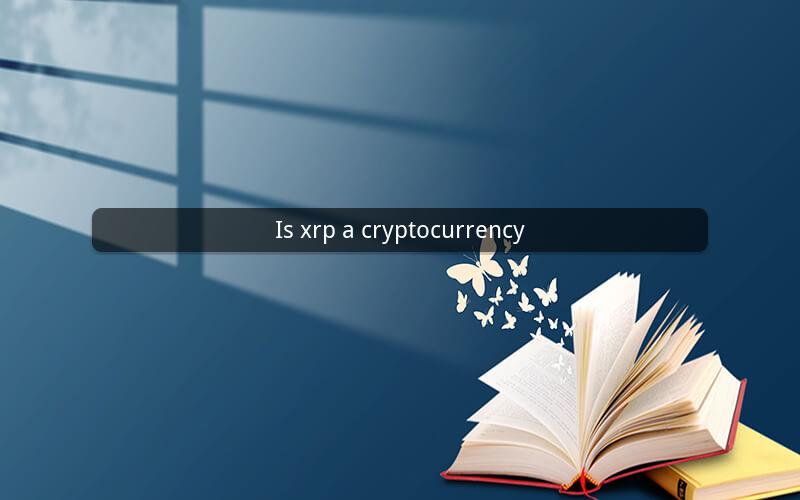
Is XRP a Cryptocurrency?
Table of Contents
1. Introduction to XRP
2. Understanding Cryptocurrencies
3. The Relationship Between XRP and Cryptocurrencies
4. Unique Features of XRP
5. Market Performance of XRP
6. The Role of XRP in the Financial Industry
7. Regulatory Environment and Challenges
8. The Future of XRP
9. Conclusion
1. Introduction to XRP
XRP is a digital asset that was created in 2012 by Ripple Labs Inc. It is designed to facilitate the movement of money across different currencies and payment networks. Unlike Bitcoin, which was created as a decentralized cryptocurrency, XRP operates as a digital asset that can be used by financial institutions to streamline cross-border transactions.
2. Understanding Cryptocurrencies
Cryptocurrencies are digital or virtual currencies that use cryptography to secure transactions and control the creation of new units. They are typically decentralized, meaning they are not controlled by any central authority. Bitcoin, the first cryptocurrency, was introduced in 2009, and since then, numerous other cryptocurrencies have been developed.
3. The Relationship Between XRP and Cryptocurrencies
XRP is often classified as a cryptocurrency, but it has some distinct characteristics that set it apart from other digital assets. While XRP shares some similarities with other cryptocurrencies, such as its decentralized nature and the ability to be transferred over the internet, it also has unique features that differentiate it from traditional cryptocurrencies.
4. Unique Features of XRP
4.1 Speed: XRP transactions are extremely fast, with a confirmed transaction time of less than 4 seconds. This is significantly faster than traditional banking systems and even other cryptocurrencies like Bitcoin.
4.2 Scalability: XRP has the ability to handle a high volume of transactions per second, making it suitable for large-scale applications such as international money transfers.
4.3 Low Transaction Fees: XRP transactions are inexpensive, with fees typically ranging from 0.00001 to 0.00002 XRP per transaction.
4.4 Interoperability: XRP can be used to facilitate the exchange of different currencies, making it an ideal asset for cross-border transactions.
5. Market Performance of XRP
XRP has experienced significant volatility in its market performance. Since its inception, the value of XRP has fluctuated widely, with periods of rapid growth followed by periods of decline. Its market capitalization has reached billions of dollars at times, but it has also experienced significant losses.
6. The Role of XRP in the Financial Industry
XRP has gained traction in the financial industry due to its unique features. Financial institutions, such as banks and payment processors, are exploring the use of XRP to streamline cross-border payments and reduce costs. Ripple, the company behind XRP, has partnered with several financial institutions to implement its technology in real-world applications.
7. Regulatory Environment and Challenges
The regulatory environment for cryptocurrencies is still evolving, and XRP is no exception. The legal status of XRP varies by country, with some governments considering it a currency, while others classify it as a security. This regulatory uncertainty poses challenges for the adoption and growth of XRP.
8. The Future of XRP
The future of XRP remains uncertain, but there are several factors that could influence its growth. Continued partnerships with financial institutions, advancements in Ripple's technology, and regulatory clarity could all contribute to the growth of XRP.
9. Conclusion
XRP is a digital asset that has unique features that make it a valuable tool for financial institutions. While it shares some similarities with other cryptocurrencies, its interoperability, speed, and low transaction fees set it apart. The future of XRP will depend on its ability to navigate the regulatory landscape and gain widespread adoption in the financial industry.
Questions and Answers
1. What is the primary purpose of XRP?
- XRP is designed to facilitate the movement of money across different currencies and payment networks.
2. How does XRP differ from Bitcoin?
- XRP has faster transaction times, higher scalability, and lower transaction fees compared to Bitcoin.
3. What is the role of Ripple in the XRP ecosystem?
- Ripple is the company behind XRP and develops the technology that supports its use in various applications.
4. How does XRP handle cross-border transactions?
- XRP can be used to facilitate the exchange of different currencies, making it an ideal asset for cross-border transactions.
5. What are the advantages of using XRP for international money transfers?
- XRP offers fast transaction times, low transaction fees, and high scalability, making it advantageous for international money transfers.
6. How does the regulatory environment affect the adoption of XRP?
- The regulatory environment can impact the adoption of XRP, as it varies by country and can affect the legal status of the asset.
7. What are the potential challenges for XRP in the future?
- Potential challenges for XRP include regulatory uncertainty, competition from other cryptocurrencies, and market volatility.
8. How does XRP contribute to the financial industry?
- XRP contributes to the financial industry by streamlining cross-border payments, reducing costs, and improving efficiency.
9. Can XRP be used as a store of value like Bitcoin?
- While XRP can be used as a medium of exchange, it is not commonly considered a store of value like Bitcoin.
10. What is the potential impact of Ripple's partnerships on the adoption of XRP?
- Ripple's partnerships with financial institutions can help promote the adoption of XRP by providing real-world use cases and increasing credibility.